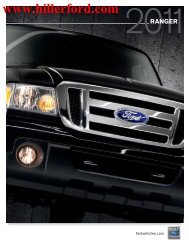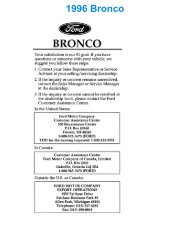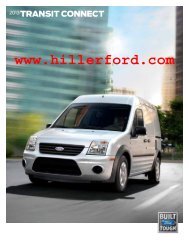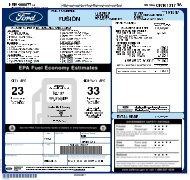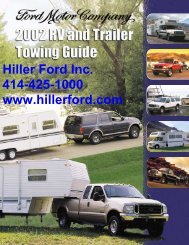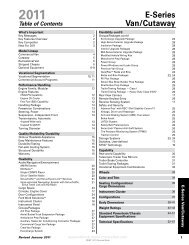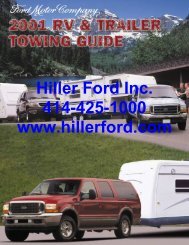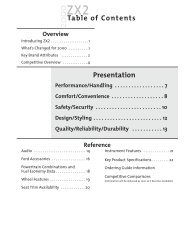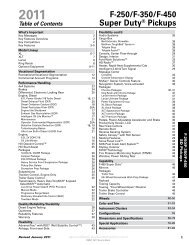You also want an ePaper? Increase the reach of your titles
YUMPU automatically turns print PDFs into web optimized ePapers that Google loves.
F-<strong>150</strong><br />
<strong>2012</strong><br />
Personal Safety System<br />
F-<strong>150</strong><br />
Safety/Security<br />
The Personal Safety System uses a number of different<br />
safety features working together to help protect the<br />
driver and right front passenger in the event of certain<br />
frontal collisions. System components include:<br />
• Dual-stage driver and right front passenger airbags<br />
• Restraint Control Module<br />
• Electronic crash severity sensor<br />
• Front Passenger Sensing System<br />
• Driver-seat position sensor<br />
• Front outboard safety belt pretensioners<br />
• Front outboard safety belt energy<br />
management retractors<br />
NOTE: See the Safety section in the Source Book<br />
Appendices or on eSourceBook for more information.<br />
Safety Canopy System with Roll Sensor<br />
• Side curtain airbags provide head protection for all<br />
outboard seating positions<br />
• System includes side curtain airbags and roll sensor<br />
• Located in the roof side rail behind the headliner, the<br />
side curtain airbags deploy downward and outward<br />
toward the side window opening to protect the<br />
heads of outboard passengers in both rows<br />
• Side air curtains are triggered independently of the<br />
driver and front passenger airbags by side-impact<br />
sensors or by the roll sensor<br />
• Roll-fold technology helps the airbag slide between<br />
the glass and occupant as it inflates<br />
• Side curtain airbags will not interfere with properly<br />
installed child safety seats or booster seats<br />
• Canopy is designed to stay inflated longer for added<br />
protection in a rollover or multiple side impacts<br />
Front-seat Side Airbags<br />
• Designed to protect chest and torso of the<br />
driver and front passenger in the event of a<br />
side-impact collision<br />
• Airbags deploy from the side of the seatback bolsters<br />
so that they always inflate to provide maximum<br />
protection, regardless of the seat fore/aft position<br />
Occupant Protection<br />
Body Structure<br />
• Dual hydroformed front tubes on either side of the<br />
engine bay are shaped to absorb impacts<br />
• Cab strength is enhanced with continuous tubes<br />
running from the A-pillar base through the roof rail<br />
that feature the industry’s first use of hydroformed<br />
ultra-high-strength steel<br />
• Rear cab header is boxed for extra strength<br />
• Stamped steel front “horns” ahead of the strong<br />
hydroformed front frame rails help manage crash<br />
forces. These areas are designed to collapse in<br />
accordion fashion, helping to dissipate crash energy<br />
before it reaches the passenger compartment<br />
• A torque box just ahead of the front doors helps<br />
to guard against deformation of the footwell and<br />
helps direct crash forces along the high-strength<br />
rocker panel, helping to prevent intrusion into the<br />
passenger compartment<br />
• Side door intrusion beams provide added structural<br />
stability to help protect occupants in the event of<br />
certain side impacts<br />
Safety Belts<br />
• Three-point safety belts are standard for all<br />
passengers, including front and rear center<br />
seating positions<br />
Head Restraints<br />
• Standard for all seating positions, including secondrow<br />
center seating position<br />
• Help optimize head and neck position in certain<br />
types of collisions<br />
Autolock/Unlock<br />
• Automatically locks the doors when all doors are<br />
closed and the vehicle reaches a speed greater than<br />
5 mph (8 km/h)<br />
• Doors automatically unlock when the transmission is<br />
placed in the Park position<br />
• Vehicle ignition must be in the On position and the<br />
transmission in gear for the system to function<br />
26 esourcebook.dealerconnection.com<br />
RE&T: <strong>2012</strong> Source Book<br />
July 2011



